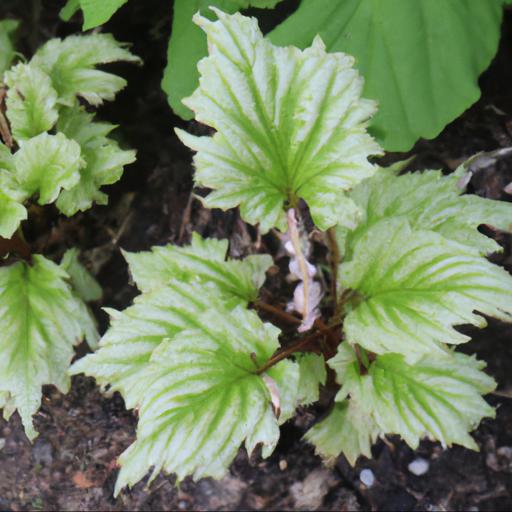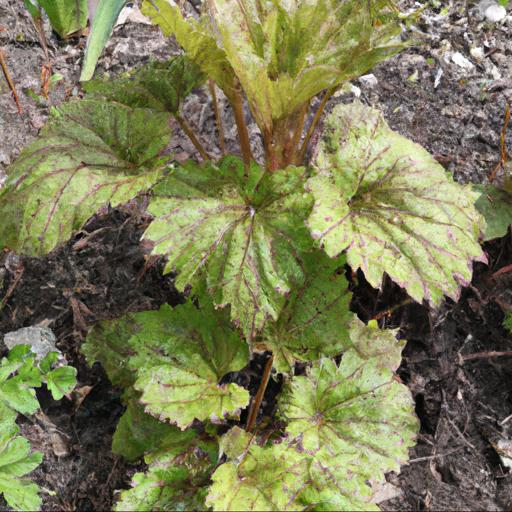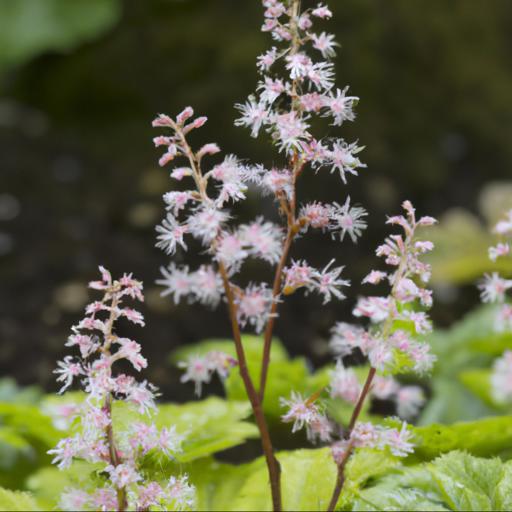Tiarella cordifolia, commonly known as foamflower, is an attractive, low-growing perennial plant with delicate foliage and white flowers. It is native to North America and is widely used as a groundcover in gardens and landscaping.
It is also known for its medicinal properties and its ability to thrive in shady areas. In this blog, we will explore the many benefits of Tiarella cordifolia, from its ornamental value to its medicinal uses. We will also discuss how to care for and propagate this hardy plant.
With its attractive foliage, easy-care nature, and numerous benefits, Tiarella cordifolia is an excellent addition to any garden.
Benefits of growing tiarella cordifolia

Tiarella cordifolia is a perfect choice for UK gardeners looking to enhance the beauty of their gardens. This versatile, shade-tolerant, low-maintenance perennial makes an excellent addition to any landscape.
Not only is it attractive in appearance, but tiarella cordifolia also has some great benefits for gardeners. From its hardy foliage, to its ability to help improve the soil and water conditions in your garden, growing tiarella cordifolia can truly be a rewarding endeavor that provides plenty of rewards. One of the greatest benefits of growing tiarella cordifolia is its ability to survive and thrive in a variety of conditions.
This shade-loving plant can flourish in partial sun or full shade, making it a great choice for those with limited outdoor space or difficult soil conditions. Its hardy foliage also makes it an ideal ground cover for larger garden areas, and it is also able to withstand cool climates better than many other shade loving plants. Another reason why tiarella cordifolia is highly prized by gardeners is due to its strong root system.
This plant will quickly propagate and spread into denser areas, creating excellent ground cover and improving the soil conditions as it grows. The roots of the tiarella cordifolia are also able to tolerate poor soil conditions, and will efficiently work to soften the soil and improve drainage.
This makes it an excellent choice for gardeners attempting to revitalize their soil and create healthier, longer lasting lawns and gardens. Overall, terellia cordifolia is a great choice for gardeners looking to add some beauty and nutrition to their gardens. Its ability to survive and thrive in a variety of climates, as well as its hardy foliage and strong root system, make it an ideal choice for those looking to establish lush, healthy lawns and gardens.
Additionally, this shade-loving perennial has numerous other benefits, such as improving soil structure and water drainage, as well as helping to protect surrounding plants from frost damage. Gardeners should definitely consider the benefits of this amazing plant when looking to enhance the beauty of their landscape.
Tips for planting and caring for tiarella cordifolia

Tiarella cordifolia, also known as foamflower, is a stunning shade-loving perennial that adds texture and beauty to woodland gardens and shady borders. With its delicate foliage and showy winter blooms, tiarella cordifolia is an excellent choice for landscaping and container gardening. If you’re looking to add this showy perennial to your garden, or if you’re a gardening enthusiast who’s simply curious, here are some tips for planting and caring for tiarella cordifolia.
When planting tiarella cordifolia, it’s best to select a location in partial shade. Foamflower is a woodland plant and does best in soil that is organically rich and slightly moisture-retentive.
It will grow in a range of soils, from sandy to clay loam, but is most successful when it is planted in well-drained soil. Be sure to avoid planting tiarella in overly damp soil, as the roots will quickly rot. When planting, you should set the crown of the plant about an inch below the soil surface and then water it deeply.
Once planted, tiarella cordifolia will require regular watering during its first few weeks of establishment. After it is established, however, it doesn’t need as much water.
Unless your area is experiencing a period of drought, it’s best to allow the soil around to dry out in between waterings. As it is a shade-loving perennial, tiarella cordifolia will appreciate being planted in mulched beds to help the soil retain moisture.
Foamflower is generally easy to maintain once it is established. It’s a low-maintenance plant and requires little fertilizer, with occasional mulching and occasional pinching of the spent blooms in the early spring to encourage bushier growth. Furthermore, tiarella cordifolia usually does not suffer from any serious disease or pest problems, so it should remain vibrant and healthy for many years to come.
Common pests and diseases of tiarella cordifolia

Tiarella cordifolia, also known as Foamflower due to the ‘foamy’ white-pink blooms which are described as a mix of ‘snowflakes and candyfloss’, is a hardy perennial flowering herbaceous plant, typically found in humid and acidic woodland environments. While the species is generally low-maintenance, it can become vulnerable to some common pests and diseases which may endanger their health and longevity. Among the pests which can cause damage to Tiarella cordifolia include leaf miners which feed on the foliage and can spread quickly, as well as aphids, thrips, and spider mites.
These pests can stunt leaves or cause discoloration, reduce flowering, and leave behind a sticky, sugary residue known as honeydew. These pest infestations may be treated by washing away with a garden hose, or by spraying pesticides and insecticidal soaps.
In order to protect the health of your Tiarella cordifolia, it’s important to be aware of the signs of disease. Fungal diseases such as powdery mildews and rusts can cause the tiarella cordifolia to become susceptible to damage by insects, while root rot may be caused by overwatering or poor drainage.
Additionally, leaf spots can create yellow and brown spots on the leaves, leading to deformity if untreated. Treating fungal diseases may require fungicides, and improved care in regards to watering and drainage will help to protect against root rot. In order to ensure the long-term health of your Tiarella cordifolia, it’s important to monitor for signs of pests and diseases.
By proactively treating infestations from pests, as well as ensuring proper watering and drainage, your Tiarella cordifolia will be able to thrive for years to come.
How to use tiarella cordifolia in landscaping
. Tiarella cordifolia is an interesting and beautiful plant to incorporate into landscape designs. Also known as foamflower or false miterwort, this woodland perennial grows in shady woodlands and dappled sunlight and is considered a great low maintenance addition to any garden space.
As a part-shade plant, it is particularly useful in shady gardens or shady areas of the yard and can enliven shady beds and borders. Tiarella cordifolia is an excellent plant for both landscaping and mass planting.
As a perennial, its foliage tends to be evergreen and it comes in a range of shapes and sizes, from tall, slender mounding varieties to short, delicate dome shapes. The foliage can range from bright green to purple, red, and even black. The white flower blooms appear in early spring and last through mid-summer.
To use tiarella cordifolia in landscaping, begin by planting a few specimens in beds or borders that receive morning or late day shade. When situated in the right growing conditions, this plant is a low maintenance gem that can enhance any garden.
The mounding forms are ideal for mass plantings and provide great foundational structure, while the domed varieties make great accents in smaller spaces. It can also be grown in containers, either in the ground or hung from the wall.
In general, tiarella cordifolia requires minimal care throughout the growing season, with just a little pruning in the early spring to maintain shape and size. It is important to water the plant in dry spells and, of course, top dress with mulch to maintain moisture levels. With minimal maintenance and effort, this beautiful and adaptable plant will bring joy and excitement to your landscape for the long-term.
Final Touch
Tiarella cordifolia, commonly known as Foamflower, is a perennial flowering plant native to North America. It produces small white or pink flowers in the spring and is often used in gardens for its attractive foliage and low-maintenance care. It is also a popular choice for naturalizing wooded areas and shady gardens.
Foamflower is a hardy plant that is easy to grow and requires little maintenance. It is an excellent choice for adding texture and color to the garden.
FAQ
What are the common names for Tiarella cordifolia?
The common names for Tiarella cordifolia are foamflower, cool-season foamflower, and heartleaf foamflower.
What is the native range of Tiarella cordifolia?
Tiarella cordifolia is native to North America, from Newfoundland to Manitoba in the north, and from Florida to Texas in the south.
How does Tiarella cordifolia reproduce?
Tiarella cordifolia reproduces by seed, rhizomes, and stolons.
What are the ideal growing conditions for Tiarella cordifolia?
The ideal growing conditions for Tiarella cordifolia are moist, well-drained soil in partial shade. It prefers acidic soil and can tolerate full shade. It should be protected from strong winds and should be watered regularly.
What are the benefits of growing Tiarella cordifolia?
The benefits of growing Tiarella cordifolia include its attractive foliage, low maintenance requirements, and its ability to thrive in shady areas. It is also deer-resistant and drought-tolerant, making it a great choice for gardens in dry climates. Additionally, it is a low-growing plant, making it a great choice for ground cover or edging.
What pests or diseases are associated with Tiarella cordifolia?
Common pests and diseases associated with Tiarella cordifolia include powdery mildew, slugs, aphids, and leaf spot.

